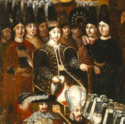Mahfiruz Hadice Sultan
| Mahfiruz Hadice Sultan | |
 | |
| Född | 1590 (cirka) |
|---|---|
| Död | 1620 Istanbul |
| Begravd | Eyüpsultan Cemetery |
| Andra namn | Mahfiruz |
| Medborgare i | Osmanska riket |
| Sysselsättning | Slav |
| Befattning | |
| Valide Sultan | |
| Partner | Ahmed I |
| Barn | Osman II (f. 1604) Şehzade Bayezid (f. 1612) |
| Redigera Wikidata | |
Mahfiruz Hadice Sultan född 1590, död okänt år, var mor till sultan Osman II.
Hon ska ha varit från Cirkassien; en tidigare uppgift om att hon ska ha varit grek anses inte längre trolig. Vid sitt inträde till det kejserliga osmanska haremet som konkubin till Ahmed I fick hon enligt sedvana ett persiskt namn, i hennes fall Mahfiruz ('Ärofull Måne'). Hon blev 1604 mor till tronföljaren.
Datumet för hennes död är okänt. År 1612 finns uppgifter om att sultanen ska ha gett order om fysisk bestraffning av en haremskvinna som gjort hans favorithustru Kösem Sultan, och denna kvinna kan ha varit Mahfiruz. Hon tros ha förvisats från hovet av sultanen på Kösems önskan under 1610-talet.
Hennes son besteg tronen år 1618, och hon borde då ha fått titeln valide sultan och blivit haremets högst rankade kvinna. Haremets efterlämnade dokument har dock inte bekräftat existensen av någon valide alls under den tiden: år 1620 fick däremot sultanens gamla amma en så hög inkomst att hon förmodas ha övertagit uppgifterna som validen normalt skötte i haremet. [1]
Mahfiruz tycks vid någon tidpunkt ha råkat i onåd: hon är inte begraven vid sin make, utan i Eyüb.
Källor
Noter
- ^ Peirce, Leslie P. (1993). The Imperial Harem: Women and Sovereignty in the Ottoman Empire. Oxford University Press. pp. 233–. ISBN 978-0-19-508677-5.
Media som används på denna webbplats
Författare/Upphovsman: Okänd, Licens: CC BY 4.0
"The enthronement of Sultan Osman II (r.1618-22), by a European artist travelling with the Austrian Ambassador Baron Mollard. The enthroned Osman II is presented facing his mother, Mahfiruz Sultan, the head of the Imperial Harem. She is wearing a gold crown and is surrounded by her maids of honour. The birth of Sultan Osman II marked the moment in which her husband, Sultan Ahmed I, became the youngest Ottoman Sultan to ever become a father. Upon Osman’s enthronement in 1618, she left the old palace (Eski Saray) in the Bayezid district and moved to the Imperial Harem in the Topkapi Palace.
The iconic Ayasofya Mosque portrayed in the background frames the scene and sets the importance of the moment, as do the figures of the müezzins on the minarets who appear to be announcing the call to prayer (ezan). The grand mufti (şeyhülislam) Hoca Ömer Efendi, Osman II’s tutor (hace-i sultani), is situated directly in front of the Imperial Mosque; presenting the holy Qur’an towards the audience and blessing the young ruler. The grand mufti was one of the leading political figures behind the dethronement of the previous Sultan, Mustafa I (r.1617-18 and 1622-23), paving the way for Osman II’s ascension to the throne. The musicians and dervishes surrounding Hoca Ömer Efendi were most probably from the mevlevi dervish lodge, and appear to be performing a Sufi ritual (mevlevi ayini) in order to obtain a divine blessing for the recently enthroned Sultan. The chief-black-eunuch of the Imperial Harem (kızlar ağası), Süleyman Ağa, is depicted beside the Sultan as his duty was to accompany the prince to the throne and supervise the ceremony. The sword-bearer (silahdar ağa) is positioned behind him, holding a bejewelled box which was to be presented as an imperial gift to the Sultan. The sword-bearer’s responsibility was to escort the prince from his private chamber in the Topkapi Palace to the throne. Wearing a red kaftan behind him is the solak (imperial guard), guarding the enthroned monarch. In front of the Emperor’s mother appears the grand-vizier, Sofu Mehmed Pasha (d.1649), holding a mace.
The Austrian ambassador, Baron Hans Mollard von Reinek, is painted in distinctly European attire with a large feathered hat. Below the enthronement scene are the various members of the public and imperial chancery who have gathered in order to take part in the ceremony".